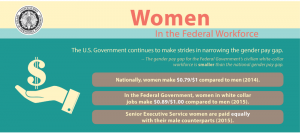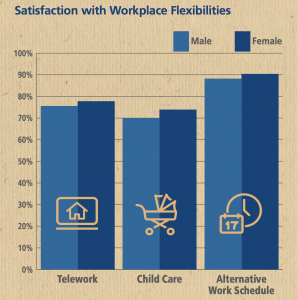Should the U.S. Government be the employer of choice for women looking to advance their careers? Are female federal employees better off than their corporate counterparts? Today, the Washington Post released a study on compensation trends between men and women in various federal agencies, along with an opinion piece praising the opportunities for women in federal government.
The Report
The Post analyzed compensation data from the Office of Personnel Management (OPM):
The data includes characteristics like gender, occupation, education and length of service but not workers’ names… for civilian, full-time, permanent federal employees… based on billions of comparisons of federal workers with similar education, length of service and job categories. Every woman was matched with every man with similar characteristics to see who had a higher salary.
Overall, the Post concluded that women have better odds of reaching senior leadership positions and having something closer to pay equity in the federal government than in corporate America. In fact, “among the 7,187 career senior executives, they’ve reached pay parity, with women getting a slight edge.”
The report includes handy interactive graphics, so you should check it out in its entirety (which is actually pretty brief).
The Female Federal Employee Experience
 The experience of female federal employees is bolstered by organizations like FEW (Federally Employed Women), which “works as an advocacy group to improve the status of women employed by the Federal government;” and like Executive Women in Government, which works to “prepare, promote, support and mentor women in senior leadership positions in the Federal Government.”
The experience of female federal employees is bolstered by organizations like FEW (Federally Employed Women), which “works as an advocacy group to improve the status of women employed by the Federal government;” and like Executive Women in Government, which works to “prepare, promote, support and mentor women in senior leadership positions in the Federal Government.”
But that doesn’t tell us much about the actual experience of female federal employees. Anita Blair, Deputy Assistant Secretary for Human Resources at the Treasury Department commented in 2014 that “we get a lot of smart, good women who come to the government because of that flexibility.” However, it is important to note that while female federal employees who have access to things like alternative work schedules and telework options report high levels of satisfaction, not everyone has access to those programs.
For example, many of my friends working at the Department of Justice have expressed frustration at the fact that whether one gets paid maternity leave or things like child-friendly scheduling policies varies section by section — within DOJ. This means that they have to depend on the sympathies of their supervisors if they are hoping to get any sort of paid leave.
There is no standardized access to paid maternity or parental leave in the federal government.
President Obama did issue a Presidential Memorandum “direct[ing] agencies to advance Federal workers up to six weeks of paid six leave to care for a new child or an ill family member” and asked Congress to pass legislation granting “six weeks of paid parental leave.” In other words, although the Obama Administration has taken steps to make things better, there is no standardized access to paid maternity or parental leave in the federal government. That is, for many women I know, a very big consideration in whether an employer is, in fact, an employer of choice.










